Past research projects
Past research projects
ACLA1 (2004-2007)
Professor Gillian Wigglesworth, Patrick McConvell and Professor Jane Simpson
The Aboriginal Child Language Project 1 was funded by an Australian Research Council Discovery Grant. The project investigated the type of input children receive in multilingual environments that include a traditional language, a contact variety of English and code-mixing between languages and speech styles. It involved case studies of three Aboriginal communities.
ACLA2 (2011-2015)
Professor Gillian Wigglesworth and Professor Jane Simpson
The Aboriginal Child Language Acquisition Project identified how well Indigenous Australian children manage the major change from a home environment, in which Standard Australian English is not the dominant code, to the school environment, in which it is the main code. This research allowed us to determine whether, and to what extent, the different codes the children bring from home, and the demands made of them in the school, affect their ability to manage and fully participate in the school environment.
A longitudinal study of the interaction of home and school language in three Aboriginal communities (2008-2014)
Professor Gillian Wigglesworth and Professor Jane Simpson
ARC Discovery Project DP0877762
The importance of language skills cannot be underestimated, and contribute to 'a healthy start to life'. In multilingual Indigenous communities, children must negotiate the complexities of different languages used for different purposes. This project provided detailed insights into how children manage differences between home and school language, the kinds of problems they encounter when they enter the school system, and how their languages develop over the first four crucial years of school which provide the foundation for the children's future education. Their ability to manage the language of school underpins their ability to lead successful and engaged lives as adults.
Children's Perspectives On Growing Up Multilingual At Warruwi Community (2011-2014)
Dr Ruth Singer
Two Faculty of Arts research grants and an Early Career Researcher grant, the University of Melbourne
Warruwi Community, Arnhem Land is one of very few places in Australia where children grow up speaking more than one traditional Indigenous language. This project investigated language use at Warruwi Community through biographical interviews, participant observation and the analysis of multilingual conversations. The project examined the relationships between Indigenous languages at Warruwi Community to identify how so many small languages are maintained in this community. Although the set of languages spoken at Warruwi Community has changed since White contact, the way that multilingualism is practiced seems to reflect long standing practices underpinned by persisting language ideologies and attitudes to multilingualism.
The project looked at three age groups: adults, school children 6-10 years and adolescents 15-18 years. This study showed how strong indigenous languages have been maintained within multilingual communities so that we can work out how better to support Indigenous languages. The study also contributed to international debates around the nature of language change in small, highly multilingual communities, which are thought to have been the norm throughout most of human history.
Doing great things with small languages (2009-2014)
Associate Professor Nick Thieberger and Professor Rachel Nordlinger
Linguists routinely record minority endangered languages for which no prior documentation exists. This is vitally important work which often records language structures and knowledge of the culture and physical environment that would otherwise be lost. However, while it is typical for the interpretation and analysis of this data to be published, the raw data is rarely made available... How do we embed theoretical research work in responsible fieldwork so that we can create good primary data for longterm reuse by the speaker communities we work with and by other researchers? How can we build shared digital infrastructure to support collaborative research, both within Australia and internationally?
He's not heavy, he's my brother (2013-2016)
The acquisition of kinship terminology in a morphologically complex Australian Language
Dr Joe Blythe
Discovery Early Career Researcher Award
Of the 250+ Aboriginal languages spoken pre-contact, only 18 are still being learned by children. One of these is Murrinhpatha. Extended family networks lie at the nexus of the social universe and of Murrinhpatha's very complex grammar. This project investigated how children acquire the grammar and lexicon of kinship. It furthered the continuity of Murrinhpatha and other strong languages by investigating the attainment of grammatical and social competence, thus placing Australia at the forefront of kinship acquisition, morphologically complex language acquisition and scientifically targeted language maintenance.
Narrative art (2011-2013)
Multimodal documentation of speech, song, sign, drawing and gesture in Arandic storytelling traditions from Central Australia
Dr Jennifer Green
ELDP Individual Postdoctoral Fellowship IPF0173
In Central Australia the expressive potentials of verbal and visual art forms are combined in multimodal narratives that incorporate speech, song, sign language, gesture and drawing. These stories are a highly valued yet endangered part of the traditions of Central Australian peoples. The project took a multimodal and multidisciplinary approach to the documentation of stories from the Arandic language group - a group of closely related languages spoken by about 5,500 people. It provided a significant record of these narrative practices and provided rich data sets for analyses that enhance our understanding of how multimodal communicative systems work.
New methodologies for representing and accessing resources on endangered languages: a case study from South Efate (2004-2006)
Associate Professor Nick Thieberger
ARC Discovery Project DP0450342
Linguists produce material which has immense cultural significance as it is often the only record of endangered cultures. With new technologies come new ways of working with indigenous languages. This project developed an innovative methodology for documenting and archiving data from a language of the Pacific. It did this by linking a dictionary, texts, audio, video, images and a grammar in order to facilitate presentation of both the data and its analysis to speakers, fellow linguists, and the general public. The methodology developed during this project resulted in innovative linguistic data management techniques conformant to emerging international standards.
Stories around a sand space (2011-2013)
Multimodal interaction in Central Australian Aboriginal sand drawing narratives
Dr Jennifer Green
ARC Discovery Project Fellowship DP110102767
Central Australian Aboriginal sand stories are a unique form of storytelling that incorporates speech, song, gesture, signs and drawn graphic symbols. This project enhanced our understandings of these narrative traditions and provided insight into the complexities of multimodal communicative systems as they are used in day‑to‑day interactions.
Structure and meaning in three Australian Languages (2011-2013)
Professor Janet Fletcher, Dr Marija Tabain (La Trobe) and Dr Ruth Singer
ARC Discovery grant
The tone or melody of a sentence can communicate different kinds of meaning, yet this important aspect of spoken language is still poorly understood for Australian Indigenous languages. In fact most of our linguistic models of speech communication are based on a handful of the world's languages. This project redressed this imbalance by showing how the Australian languages Mawng, Bininj Gun-wok and Pitjantjatjara use intonation in different contexts and situations. A second outcome of the project was a revision of current intonational typology to take into account the unique pronunciation features of Australian languages. This project also found out more about how intonation is used to express information structure in Mawng, in combination with word order and other strategies.
Getting in Touch: Digital resources for Indigenous languages
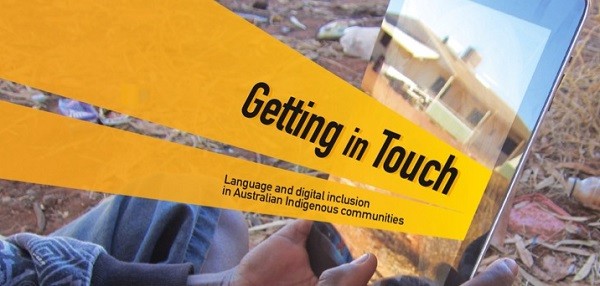
The Getting in Touch project sought to create new and meaningful language projects with Indigenous communities with respect to the development of new digital technologies. The Getting in Touch project aimed toward the concept of Digital Inclusion: making sure that Indigenous communities have support to develop digital resources in their own languages. In April 2014, a workshop was held at the Batchelor Institute's campus at the Desert People's Centre in Alice Springs. It brought together teams from Indigenous communities, linguists and technology experts.
The workshop discussed issues and ideas about digital tools for Indigenous Language Speakers. Everyone brainstormed these ideas and created maps and plans for future resources. Among those present were language teams from Maningrida, Wadeye, Warruwi (Goulburn Island), Ti Tree, Alice Springs, Willowra, Ngaanyatjarra lands, Pitjantjatjara lands, and Mwengart (McClaren Creek).
The workshop was funded by the University of Melbourne Social Equity Institute, and was supported by the Australian Government's Indigenous Languages Support Program, the Australian Research Council, Batchelor Institute and First Languages Australia.
You can read about the project, view some presentation slides and watch a short film about the project on the Centre for Australian Languages and Linguistics Getting in Touch web page.
One of the major outcomes from this workshop was the development of the Getting in Touch Bird Apps.
Learning to talk whitefella way
Learning to speak a new language requires the learner to notice the difference between his/her own speech sounds and those of the new language. But what if the learner already uses most of the words of the new language? This is the case for 20,000 remote Indigenous children and adults, speaking Kriol, a language historically based on contact between Indigenous people and English-speaking newcomers, producing a language different to both. The words are mostly derived from English, but many of the grammatical meanings mirror those in the Indigenous languages. There have also been effects on the way that Kriol is pronounced: it has inherited features of both English and the Indigenous languages' sound systems.
This project provided the first description of the sound system of Kriol based on rigorous phonological and acoustic analysis. Based on what we found out about its sound system, the project went on to study Kriol speakers' perception of sounds and words of English and Kriol. In the short term, this enabled us to pre-empt problems that Kriol-speaking children might have in learning Standard Australian English, because of the differences between the two languages. More generally, the study helped us to understand the cognitive mechanisms involved in learning new languages and in particular the role of the lexicon in this process.
Chief investigators: Assoc. Professor Brett Baker (the University of Melbourne), Dr Rikke Bundgaard-Nielsen (UWS), ARC DP130102624
The dynamics of Murrinhpatha across three generations
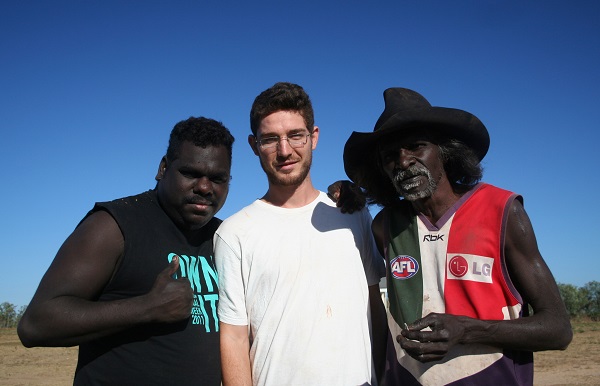
This project documented variation and change in Murrinhpatha, a polysynthetic language of northern Australia, over the last 80 years. Since settlement began in the 1930s, the Murrinhpatha speech community has undergone both radical social change, and intensive language contact. It is still learnt as L1 by all children in the town of Wadeye, and in fact enjoys growing speaker numbers, and increasing recognition as a contact language in locations as distant as Darwin and Kununurra. The majority of speakers are no longer from the traditional Murrinhpatha clans, but rather from Marri Ngarr, Marri Tjevin, Ngan'gi, Jaminjung and other language groups. Murrinhpatha is also embracing new sociolinguistic functions, as the growth of the town Wadeye foments the emergence of a distinctive local youth subculture.
The project examined phonological and morphosyntactic variables in Murrinhpatha, based on substantial corpus data compiled to represent three generational slices: pre-settlement (born 1900-1935), Catholic mission era (born 1935-1975), and contemporary (born 1975-present). Such a dataset is unprecedented in the study of Australian Aboriginal languages, and provided insight into the micro-evolution of a language that is both typologically and socially very different from any language that have previously been studied in this way.
Chief Investigator: Dr John Mansfield, COEDL postdoctoral fellow, 2015-2018
EOPAS - EthnoER online presentation and annotation system
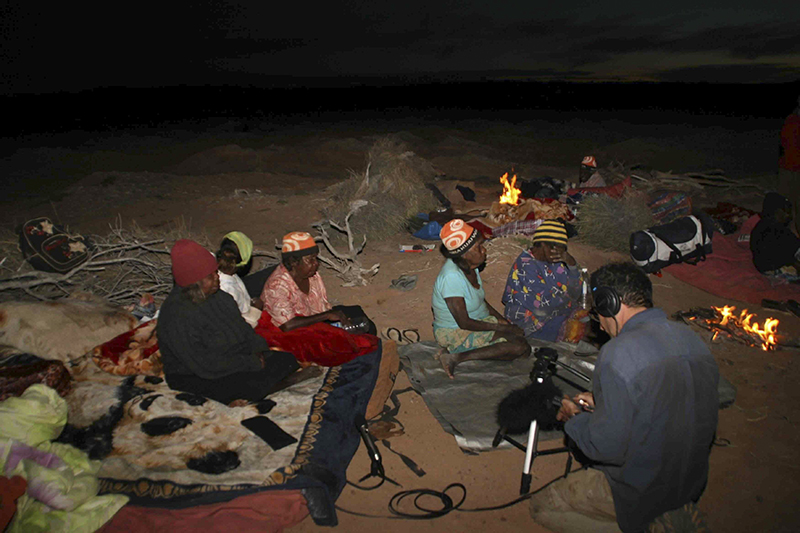
This project has provided an open-source framework for delivery of media in an application addressing the problem of how to make language data more generally available than it currently is. Users are likely to be both scholars and the general community who have an interest in the diversity of the world's languages. With the development of HTML5 we saw the possible uses of broadband-enabled media (audio and video) increase exponentially. This project has built an open-source installation (www.eopas.org/) with the aim of later creating an online network of language collections linking transcripts and media, based in the existing international network of digital language archives and leveraging their collections as the basis for a networked virtual museum of human languages. The textual system on which this was all based, called EOPAS, was developed in 2006 under an ARC eResearch grant and subsequently with a grant from the Institute for a Broadband-Enabled Society (IBES) in 2010 (now the Networked Society Institute). Research and development under an ARC DP0984419.
Chief Investigators: Associate Professor Nick Thieberger, Professor Rachel Nordlinger, Cathy Falk (Music, the University of Melbourne), Steven Bird (Computer Science and Software Engineering, the University of Melbourne), Linda Barwick (PARADISEC, University of Sydney).
What makes a multilingual community? The life of languages at Warruwi community

Warruwi Community, Arnhem Land is one of very few places in Australia where children grow up speaking more than one traditional Indigenous language. This project investigated language use at Warruwi Community through biographical interviews, participant observation and the analysis of multilingual conversations. The project examined the relationships between Indigenous languages at Warruwi Community to identify how so many small languages were maintained in this community. Although the set of languages spoken at Warruwi Community has changed since White contact, the way that multilingualism is practiced seems to reflect long standing practices underpinned by persisting language ideologies and attitudes to multilingualism. The project looked at three age groups: adults, schoolchildren 6-10 years and adolescents 15-18 years.
This study showed how strong Indigenous languages have been maintained within multilingual communities so that we can work out how better to support Indigenous languages. The study also contributed to international debates around the nature of language change in small, highly multilingual communities, which are thought to have been the norm throughout most of human history.
Chief investigator: Dr Ruth Singer, funded by an ARC DECRA postdoctoral fellowship, 2014-2017
From little things, big things grow: How children learn a morphologically complex Australian Indigenous language
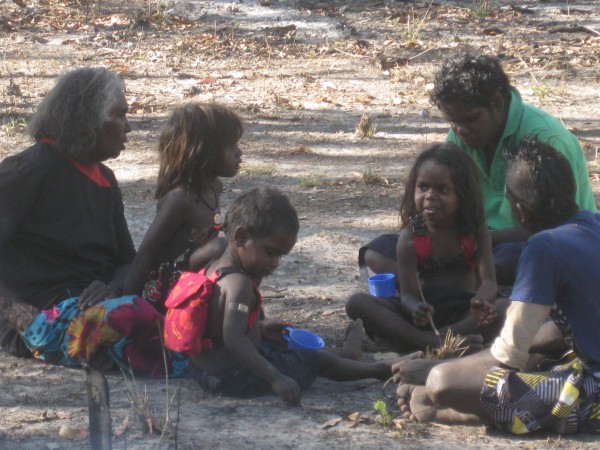
This project provided detailed study of the acquisition of Murrinhpatha (Wadeye, NT), based on the language of Murrinhpatha speaking children from 2-6 years. Although much is known about how children acquire languages such as English, there has been very little research that examines how children acquire a complex polysynthetic language like Murrinhpatha. The findings from this project have implications for our understanding of how acquisition processes are created through linguistic complexity, cognitive constraints and social interaction and how these processes differ across children acquiring radically different language types. It also provided detailed language information for the bilingual school program in Wadeye to ensure that the maintenance of Murrinhpatha is optimally managed in the early school years.
Chief Investigators: Professor Rachel Nordlinger, Dr Barbara Kelly, Professor Gillian Wigglesworth, Dr Joe Blythe , ARC discovery grant.
Documenting Burarra dialectal variation within the multilingual ecology of northcentral Arnhem Land
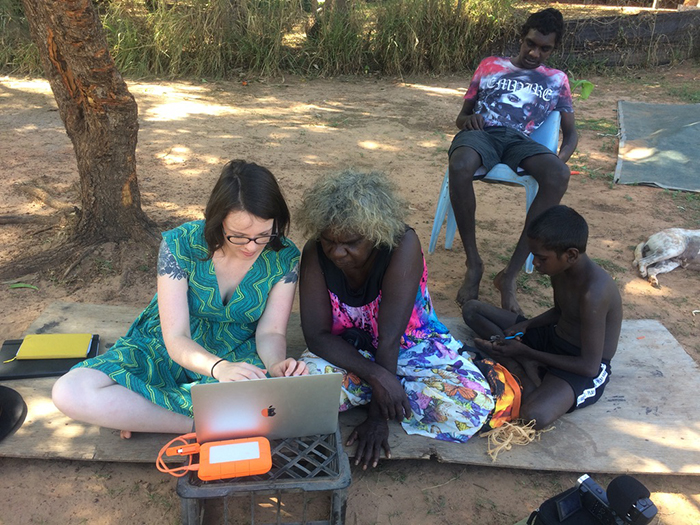
Speakers of Burarra (northcentral Arnhem Land) identity four dialects of their language: An-barra, Martay, Maringa and Gun-nartpa. However, much variation that distinguishes these varieties survives predominantly in older speakers, outside of the urban centre, Maningrida. This project explores the linguistic construction of difference in this highly multilingual context, and provides a significant record of cultural, mythological and local territorial knowledge. This is achieved through building a stratified corpus of naturalistic language use across a range of genres (traditional stories, language and clan biographies, naturalistic conversation, and elicited speech) from speakers across the Burarra region, and gathering rich data about multilingual practices and language ideologies.
This project produced an archival deposit featuring 75 hours of audio-visual Burarra recordings. It can be accessed through the Endangered Languages Archive.
Chief Investigator: Dr Jill Vaughan
Re-integrating Central Australian community cultural collections
The ARC Linkage project 'Re-integrating Central Australian community cultural collections' (LP140100806) is a partnership between the Central Land Council (CLC), the peak Indigenous representative body covering the southern half of the Northern Territory; the University of Sydney and the University of Melbourne. This project addresses 3 main questions:
- How can Central Australian Indigenous people better access their cultural records held in dispersed collections?
- How can systems be established that enable efficient and culturally appropriate mobilization of archival materials?
- How can archival access be established in ways that do not violate cultural protocols surrounding rights of access to and dissemination of cultural information?
This project will apply current research on archiving and community access to find practical solutions to managing the large amounts of recorded cultural material of interest to the Central Land Council and its constituents. It will identify and integrate information in a common database, work with community members to create a prioritised list of at-risk materials, apply locally meaningful categories for managing the archival materials, and develop strategies to support ongoing sustainability of the collections. As well as safeguarding at-risk materials, it will support Central Land Council strategic activities in land management and intergenerational knowledge transfer, and provide a framework for repatriation policy development.
Those involved are: Linda Barwick, Myfany Turpin and Petronella Vaarzon-Morel (the University of Sydney); Rachel Nordlinger and Jennifer Green (the University of Melbourne); Brian Connelly (Central Land Council)
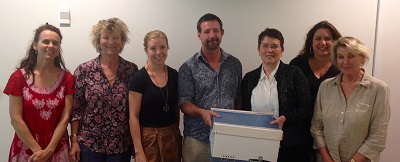
Taemi documentation project
2015 Field Methods Class: documenting Taemi (PNG)
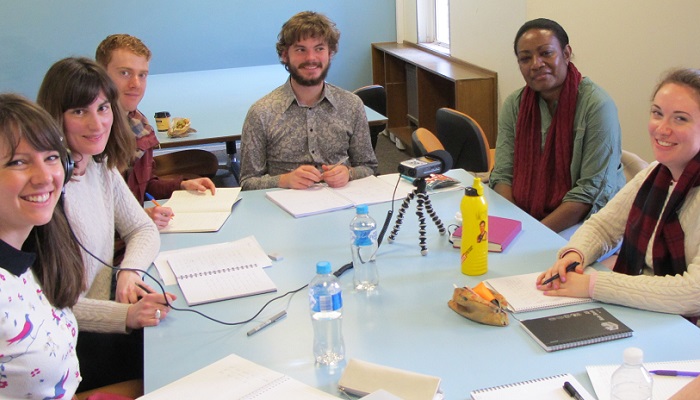
Field Methods is a class offered every second year by the School of Languages and Linguistics, for honours students. The subject provides students with the opportunity to learn the fundamentals of linguistic fieldwork, working with a native speaker of an underdocumented language, in a supported environment.
Semester two last year saw a group of dedicated students working with Gertrude Elai, a first-language Taemi speaker from Papua New Guinea, who was a student at the University of Melbourne for 2015. Taemi (or Tami) is an Austronesian language from Papua New Guinea, spoken in the Morobe provence, to the south of Lae. There has been very little work done on Taemi, and the field methods class worked with her with the goal of producing a dictionary and sketch grammar of the language. They also produced a Taemi version of the Frog Story book, which was printed and has been taken back by Gertrude to her community. When she received the copies of the book, Gertrude said: "I am over the moon, happy crying. This is so big for my people."
Strengthening Language, Strengthening Community: showcasing Mildura's Aboriginal languages

The Strengthening Language project is a project for the Aboriginal community of Mildura to share and discover more about the traditional languages of the Mildura region. We would love to hear from anyone interested in the project!
Get in touch at Mildura-languages@unimelb.edu.au or call/text Debbie Loakes on 0419364464 or Jill Vaughan on 0413856303.
This project is supported by the Helen Macpherson Smith Trust, the Melbourne Humanities Foundation, and the Research Unit for Indigenous Language.
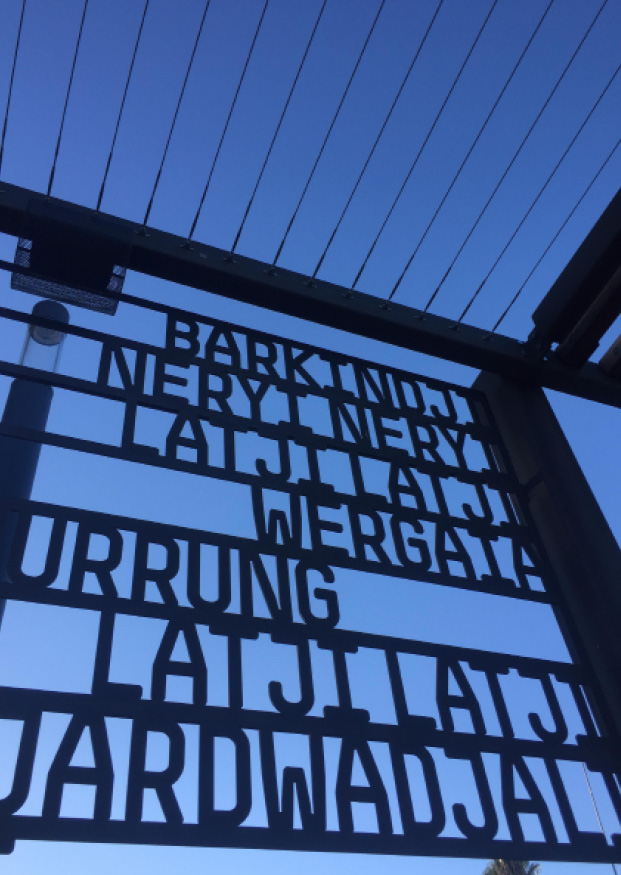
Documenting ancestral narratives in the artistic practices of north-central Arnhem Land
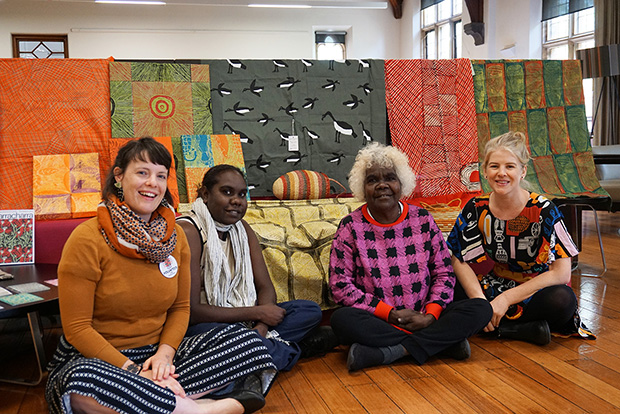
This project aims to document the multilingual ancestral stories behind traditional and emerging artistic practices in the Maningrida region of north-central Arnhem Land. In Arnhem Land, painting, weaving and sculpture are “an integral part of the aesthetics of everyday life, yet are also closely connected with the sacred” (Morphy 2005: ix). This project focuses on local artists from several language groups producing bark paintings, carvings and sculptures, weavings and fabric prints.
In collaboration with Bábbarra Women’s Centre and Maningrida Arts and Culture, high-quality audio-visual recordings will be made of these artists telling the ancestral stories represented in their artworks, and describing their artistic practices. These recordings are in several languages of this multilingual region (especially Kuninjku, Burarra, Ndjébbana and Gurr-goni), some of which are highly endangered. These will be transcribed and translated to produce subtitled videos for public use and community / online archival depositing. Mentoring of new community language workers is at the centre of this project.
Chief Investigator: Dr Jill Vaughan
Digital Daisy Bates
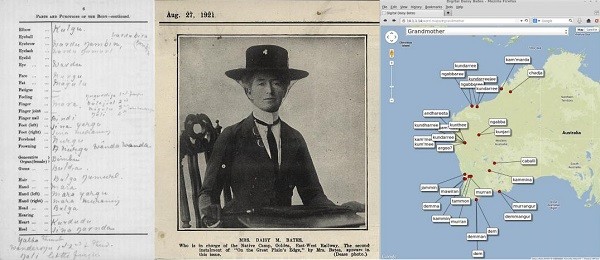
In collaboration with the National Library of Australia (NLA), this project makes accessible this extremely valuable collection of several hundred wordlists of Australian languages, originally recorded by Daisy Bates in the early 1900s. This enables reuse of the collection by Aboriginal people searching for their own heritage languages and by other researchers. The dataset is keyboarded and constructed according to the TEI Guidelines, to embody both a facsimile of the original set of manuscripts and a structured dataset for complex research questions. Access to these historical records of Australian languages will benefit from the interdisciplinary cooperation of linguists and musicologists with technology experts and with the premier collecting agency the National Library of Australia.